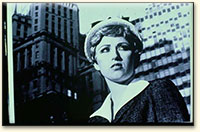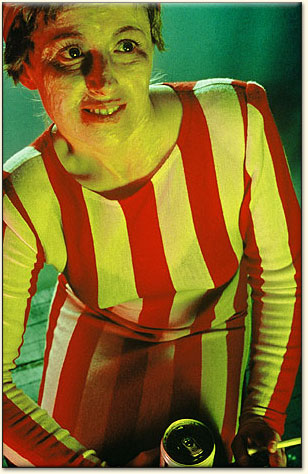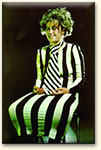Cindy Sherman's Untitled Film Stills

Untitled Film Stills # 21, Cindy Sherman, 1978. Sherman reveals gender as an unstable and constructed position, which suggests that there is no innate biological female identity.
Contemporary art often addresses conceptual concepts with political and social significance. Color and color contrasts can contribute to these conceptual meanings.
The American feminist artist Cindy Sherman (1954) is famous for the Untitled Film Stills series (1977-1980) that consist of black-and-white photographs of the artist posing in different stereotypical female roles. Although she poses for her photographs, Sherman’s pictures are not self-portraits in a traditional sense.

Untitled # 132, Cindy Sherman, 1984. With bright light and high-contrast color, Sherman focuses on the consequences of society’s stereotyped roles for women — in this case as a victim of fashion — rather than upon the roles themselves.
Modeling in several roles, she reveals gender as an unstable and constructed position, which suggests that there is no innate biological female identity. On the contrary, women adopt several roles and identities depending on their circumstances. Therefore, the roles in the Untitled Film Stills series vary from an immature schoolgirl to an attractive seducer and from a glamour diva to a caring housewife. Importantly, her work encourages self-reflection in the spectator. As Sherman argues, “I’m trying to make other people recognize something of themselves rather than me.”

Untitled # 138, Cindy Sherman, 1984. Sherman depicts a woman in designer clothes losing self-confidence who cannot bear the pressure of her forced role.
In the 1980s, Sherman introduced bright light and high-contrast color to her work. Moving away from established female stereotypes seen in the Untitled Film Stills series, she begins to deal with topics such as eating disorders, insanity and death, focusing on the consequences of society’s stereotyped roles for women rather than upon the roles themselves. Sherman’s Untitled # 132 (1984) and Untitled # 138 (1984) represent a fashion victim. Exaggerating her facial gestures, she models in fashionable clothes by top designers such Jean-Paul Gaultier and Rei Kawakubo of Comme des Garçons. However, these clothes do not feel comfortable and attractive. The woman loses her self-confidence and cannot bear the pressure of her forced role.
Compare Sherman’s earlier series to her 1980s work. Do you think that the bright yellow and red or the contrasting black and white stripes of the dresses intensify the literality of Sherman’s critical position? What is the role of the greenish background color? Sherman’s choice of colors emphasizes the grotesque character of the woman. The colors depart from their original fashionable context, failing their original promise of happiness promoted by the fashion industry. Therefore, in this feminist context, colors suggest pain, frustration and even threat, signifying the meaning of the work.